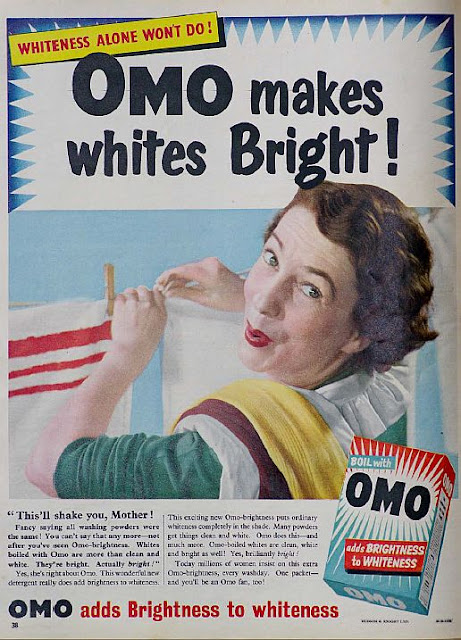OMO Print Advert
Advertising case study 1: OMO print advert
The first close-study product for Advertising and Marketing is the 1955 advert for OMO washing powder that appeared in Woman's Own magazine.
This product provides an excellent opportunity to analyse the changing representation of women in advertising over the last 60 years.
Sample questions for Advertising and Marketing
In your Media exams, you are likely to get questions similar to these:
- Why do advertisers use stereotypes? [6 marks]
- Explain how advertisements reflect the historical context in which they were created. [12 marks]
OMO advert: blog tasks
Work through the tasks in this blogpost to make sure you're an expert on this CSP.
1) What year was the advert produced?
1950
This product provides an excellent opportunity to analyse the changing representation of women in advertising over the last 60 years.
Sample questions for Advertising and Marketing
In your Media exams, you are likely to get questions similar to these:
- Why do advertisers use stereotypes? [6 marks]
- Explain how advertisements reflect the historical context in which they were created. [12 marks]
OMO advert: blog tasks
Work through the tasks in this blogpost to make sure you're an expert on this CSP.
1) What year was the advert produced?
1950
2) How were women represented in most adverts in the 1950s?
They were represented as housewives.Also they had to look presentable whilst the men come into the house.
3) How does the heading message ('OMO makes whites bright') and typography promote the product?
This is to connote that it's referring to the product.The text is sans serif
4) Analyse the mise-en-scene in the advert (CLAMPS): how is costume, make-up and placement of the model used to suggest women's role in society?
The women in the advert is wearing nice clothes and makeup while hanging the clothes. This shows that the women should should be presentable.
5) Why is a picture of the product added to the bottom right of the advert?
There is a picture of the product because they need to establish what they are selling.
6) What are the connotations of the chosen colours in this advert?
That omo makes white bright. The connotations of blue is loyalty and truth.
7) How does the anchorage text use persuasive language to encourage the audience to buy the product? Give examples. I DON'T UNDERSTAND THIS QUESTION.
8) What representation of women can be found in this OMO advert? Make specific reference to the advert and discuss stereotypes.
That the omo advert presents women to be housewives who love to wash and hang up clothes while looking presentable.
9) What is the preferred reading for this advert - what did the producers of the advert want the audience to think in 1955?
The preferred reading would be women seeing the product and thinking that it's good because now their white clothes will be bright and clean.
10) What is the oppositional reading for this advert - how might a modern audience respond to this text and the representation of women here?
A modern audience will most like take offence to the advert because it is not an accurate display of women now.

Comments
Post a Comment